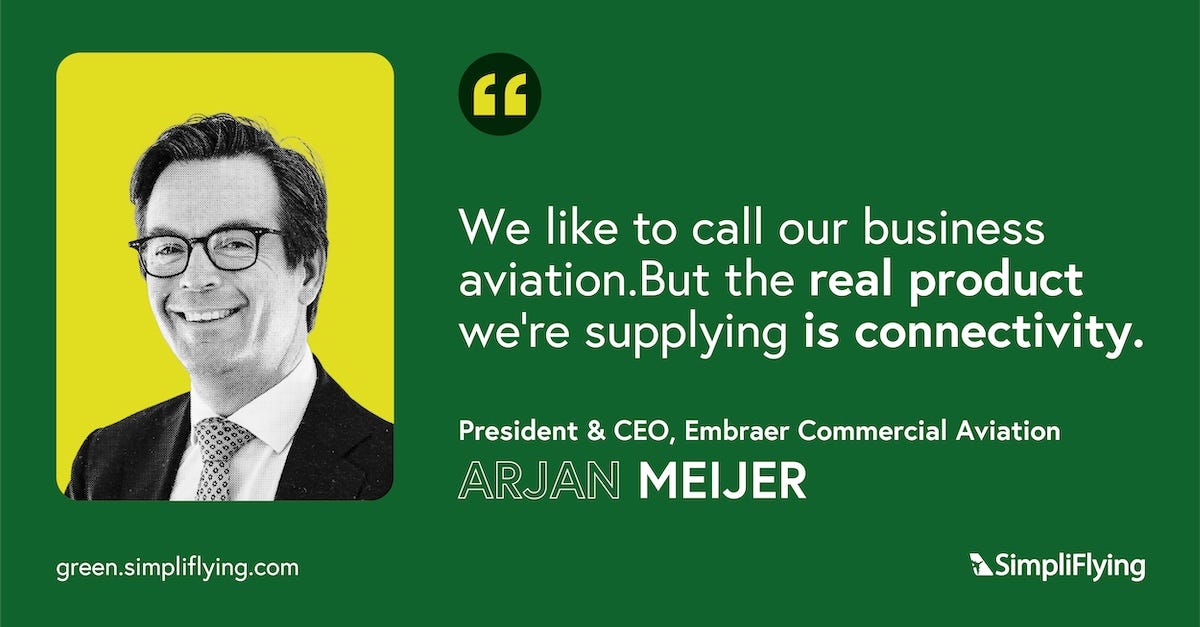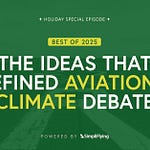Welcome to Season 3 of Sustainability in the Air, the world’s first podcast dedicated to sustainable aviation. Through in-depth conversations with top aviation leaders, we break through the clutter and provide a clear roadmap for a net-zero future.
Aircraft lie at the heart of aviation. Making efficient and greener aircraft is possibly the most effective way to cut the industry’s carbon emissions. As one of the most prominent aircraft manufacturers, Embraer has made a firm commitment to align economic goals with socio-environmental awareness.
In this episode of our ‘Sustainability in the Air’ podcast, Embraer Commercial Aviation’s President & CEO Arjan Meijer, and Vice President of Marketing and Strategy Rodrigo Silva e Souza speak with SimpliFlying CEO Shashank Nigam, and share how the aircraft manufacturer is on a mission to decarbonise regional aviation through a mix of innovative technologies.
Founded in 1969, Embraer has delivered more than 8,000 aircraft to date, and transports over 145 million passengers yearly. The E2 aircraft remains one of the quietest and most efficient single-aisle aircraft, with a 16% lower fuel burn and 30% emissions reduction. In its upcoming Energia project, Embraer is exploring diverse energy sources, propulsion architectures and airframe layouts, and expects to reduce carbon emissions by 50% starting 2030.
You can listen and subscribe to our podcast on all major podcast platforms or read our deep dive into the episode below.
If you’re rushed for time, you can also directly jump to your topic of interest by referring to these timestamps:
The Energia concept aircraft (3:00)
Embraer’s consultative approach to platform design (11:48)
Preparing the transition to hydrogen and electric aircraft (20:30)
How executive aviation can become sustainable (26:20)
Sustainability innovations in the cabin (27:45)
Eve’s eVTOL and the prospects for developing Urban Air Mobility (31:35)
Dealing with contradictions in policy-making per region (37:00)
Can planes ever compete with trains? (39:10)
Developing the quietest narrowbody aircraft in the world (43:15)
How Embraer plans to become carbon neutral by 2040 (48:10)
Rapid Fire! (52:20)
The Energia project
In 2021, Embraer unveiled the Energia project with four aircraft concepts, based on four different sustainable propulsion technologies: hydrogen fuel cell, electric, dual fuel gas turbine and hybrid-electric. The designs were targeted at the up to 50 seats segment, with smaller aircraft being powered through electric or hybrid electric motors, and the larger concepts capable of flying on hydrogen fuel cells.
Last year, however, the manufacturer streamlined its focus on two 19-30 seater designs for hybrid-electric and hydrogen-electric propulsion. “The sweet spot, if we look at the market, is probably between 20-30 seats, or maybe a little bit higher”, says Meijer. This ruled out the possibility of the proposed fully-electric design due to the high power-to-weight ratio of batteries. The dual-fuel gas turbine concept has also been put on hold. Embraer’s hybrid-electric and hydrogen-electric variants are expected to enter service in the early 2030s and 2035, respectively.
Meijer emphasises that getting to net zero will require an array of solutions. He believes that sustainable aviation fuels (SAF) are the only drop-in solution that can create a dent in aviation’s emissions. While Hydrogen also has significant potential, attaining viable production levels of green hydrogen by 2050 might not be possible.
“There’s a lot of work to be done, both on the technology and on the supply chain”, he says. The biggest and swiftest cut in emissions in the short term, Meijer explains, can only be brought about by fleet renewal.
Embraer’s unique proposition: Energia and Eve
Embraer’s Energia aircraft will cater to the regional air mobility (RAM) ecosystem — runway-based small aircraft that usually seat 9-50 passengers and have a range of 200-500 nautical miles.
Eve Air Mobility, on the other hand, is an Embraer subsidiary launched in 2020 that caters to the urban air mobility (UAM) market with its electric vertical take-off and landing (eVTOL) aircraft. By design, it will supplement and ease intra-city mobility. The aircraft is fully electric (as compared to the hybrid Energia aircraft) and will seat four passengers and a pilot. Eve eVTOLs are expected to enter service much sooner — with certification expected in late 2025.
Meijer says one of the current risks in the industry and policymaking around it is that we’re moving to bigger aircraft. As a result, shorter connections and smaller cities are going backwards on connectivity. “So we believe that regional air mobility could be a new way to allow airlines to fly to smaller airports in a fully green manner in the future,” he states.
Silva e Souza adds that Embraer is unique because it has a solution on both urban air mobility and regional air mobility. “Nobody else has this combination,” he emphasises. In fact, while some regional operators find Embraer’s RAM offering compelling, there are others who are taken by the new opportunities provided by eVTOL. According to Silva e Souza, the Eve eVTOL has the highest aircraft backlog in the company.
The ultimate opportunity, of course, is in an ever-expanding pie. “Some of the operators may start with Eve, for instance, and may eventually think about expanding their operations to regional mobility for further distances”, explains Silva e Souza.
Make some noise for the quietest jet
Embraer’s Energia and Eve aircraft are ambitious in their emission reduction aims. But the company is thinking about other aspects of aircraft sustainability as well. While much of the industry focuses on emissions reduction, Embraer is mindful about reducing noise – a critical aspect of policymaking, especially in Europe. (Consider Schiphol Airport’s recent announcement about banning all-night flights by 2025.)
Significantly, Embraer’s E2 family of narrowbody jets is the quietest in the world. Meijer is pragmatic about its benefits – after all, not only does a reduction in noise mean lower energy loss, a quieter jet is more marketable as well.
To build this aircraft, Embraer decided to retain the reliability of the E1 series jets while enhancing enough bits to get close to a clean-sheet design – new engines; a more sophisticated wing design; and a drastic reduction in aircraft drag.
“The E2 is not just the most efficient aircraft in the single-aisle space, but also the quietest in the single-aisle space. In fact, the E195-E2 is a very strong platform to not just replace the E1s but also to complement narrowbodies”, states Meijer.
He explains that the seat cost of a 195, compared to a much bigger 737 Max-8 or an A320Neo is very similar, which is attractive to customers since traditionally a smaller aircraft would have a lower trip cost but significantly higher seat costs.
The path to net zero
In 2021, Embraer announced it will achieve carbon-neutral operations by 2040. In addition, the airframer has committed to net zero operations by 2050 – which includes Scope 1, 2 and 3 emissions. While Meijer observes that 2040 is far away, he believes the company is making real progress due to a clear strategy.
For instance, Embraer recently signed an MOU with Raízen, a subsidiary of Shell Aviation, to incentivize sustainable aviation fuel (SAF) production in Brazil. In addition, the company has installed a huge number of solar panels, which will replace an annual use of 40,000 cubic metres of natural gas.
“So I think setting ESG targets on our scope one and scope two emissions has really driven us to take very clear measures”, states Meijer. He says that they also have another pilot project where natural gas will be replaced by biomethane – produced by the decomposition of organic water.
Silva e Souza adds that their Brazilian operations will, in fact, be running on 100% renewable energy a year sooner than expected, in 2024. This will enable Embraer to procure a Renewable Energy Certificate (REC) that will zero its Scope 2 carbon emissions in Brazil. “We don’t just set the targets. We have a robust action plan with deliverables for the years ahead”, concludes Meijer.
Our Take
Considering the impact greener aircraft can have in lowering emissions, aircraft manufacturers shoulder the lion’s share of the responsibility to decarbonise aviation. In this season of our podcast, we have featured two of the largest aircraft manufacturers, Boeing and Airbus. Both build larger planes for longer ranges that carry many more passengers. Embraer, however, specialises in regional, short-haul aviation.
As aviation continues to come under fire from climate activists, trains are often seen as the best alternative. However, Meijer explains that the full replacement by train scenario can realistically only work for a limited number of city pairs. For most others, train travel could involve multiple connections at a possibly higher cost of travel than planes. This is not to say that resorting to train travel is futile. Trains and planes, in fact, can complement each other – as long as aircraft emissions can be at par with that of trains.
Ultimately, the goal of the travel industry is to offer seamless connectivity. Regional aviation can be an excellent means to that end if it can be made quieter, and about as clean as trains in terms of CO2 emissions.
Meijer believes that achieving that goal would also push governments to promote regional aviation. After all, as Meijer memorably says during the podcast: “We like to call our business aviation. But the real product we’re supplying is connectivity.”
Our Sustainability in the Air podcast is powered by SimpliFlying which has been helping build trust in travel for over a decade.
This season of the podcast is brought to you by Cirium and CarbonClick. As a sustainability partner, Cirium helps the aviation industry gain a much clearer view of carbon emissions and develop methods to reduce them, enabling on the industry promise to fly sustainably. CarbonClick is the industry leader in managing transparent carbon offsetting programs for individuals and top global airlines.















